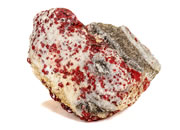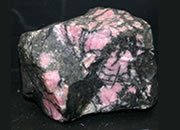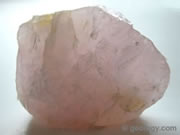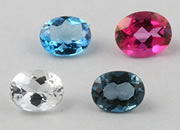Beryl
A minor ore of beryllium, and one of the most important gem minerals.
Author: Hobart M. King, PhD, GIA Graduate Gemologist
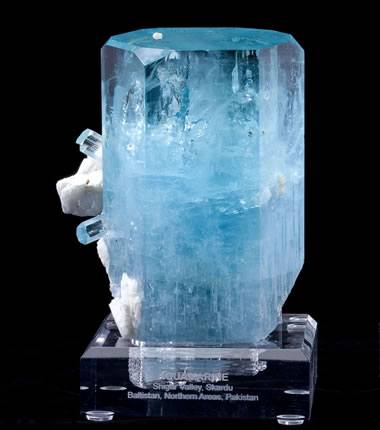
Aquamarine: A spectacular crystal of aquamarine from the Shigar Valley of northern Pakistan. This specimen clearly shows the hexagonal form with terminations and a vivid blue color. The specimen is approximately 15 x 11 x 7.5 centimeters in size. Specimen and photo by Arkenstone / www.iRocks.com.
What is Beryl?
Beryl is a relatively rare silicate mineral with a chemical composition of Be3Al2Si6O18. It is found in igneous and metamorphic rocks in many parts of the world.
Beryl has served as a minor ore of beryllium, and color varieties of the mineral are among the world’s most popular gemstones. Emerald, aquamarine, heliodor, and morganite are the most popular varieties of beryl.
Table of Contents
 What Is Beryl? What Is Beryl? Uses of Beryl Uses of Beryl Geologic Occurrence Geologic Occurrence Physical Properties Physical Properties Gem Beryls Gem Beryls Emerald Emerald Aquamarine Aquamarine Morganite Morganite Heliodor Heliodor Green Beryl Green Beryl Red Beryl Red Beryl Goshenite Goshenite Maxixe Maxixe Chatoyant Beryl Chatoyant Beryl Synthetic Beryl Synthetic Beryl |
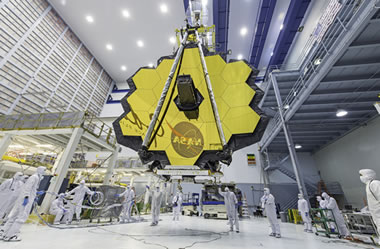
Beryllium Mirror: Most beryllium is used to make specialty alloys. It gives the alloys lightness and strength. An interesting use of the metal is in the eighteen-segment mirror of the James Webb Space Telescope. The mirror must maintain a precise shape for high-quality images. Beryllium was used because of its very light weight and its ability to hold its shape across the wide range of temperatures that will be encountered by the satellite. Image by NASA.
Uses of Beryl
Beryl once served as the world's only important ore of beryllium metal. But in 1969, Spor Mountain, Utah became the source for about 80% of the world's beryllium supply when bertrandite, a beryllium silicate hydroxide mineral, was discovered there.
The extraction of beryllium from beryl is very costly, and as long as bertrandite is available in large amounts, beryl will remain a minor ore of that metal. Small amounts of beryl, mostly produced as a by-product of gemstone mining, are still used to produce beryllium.
The most important use of beryl today is as a gemstone. It is one of the most important gem minerals, and the gems of beryl are named by their color as: emerald (green), aquamarine (greenish blue to blue), morganite (pink to orange), red beryl (red), heliodor (yellow to greenish yellow), maxixe (deep blue), goshenite (colorless), and green beryl (light green).
Emerald and aquamarine are by far the most popular varieties of gem beryl; however, the popularity of morganite has surged since about 2010. Compared to other gemstones, emeralds are second only to diamonds in terms of the dollar value imported into the United States. Occasionally, chatoyant specimens of beryl are found that can be cut into cabochons to produce interesting cat's-eye gemstones.

Cesium-Bearing Beryl from Madagascar. Specimen is approximately 1 inch (2.5 centimeters) across.
Geologic Occurrence of Beryl
Beryl is a mineral that contains a significant amount of beryllium. Beryllium is a very rare metal, and that limits the formation of beryl to a few geological situations where beryllium is present in sufficient amounts to form minerals. It mainly occurs in granite, rhyolite, and granite pegmatites; in metamorphic rocks associated with pegmatites; and, in veins and cavities where hydrothermal activity has altered rocks of granitic composition. These different types of deposits are often found together and serve as an exploration indicator for finding beryl.
Beryl is also found where carbonaceous shale, limestone, and marble have been acted upon by regional metamorphism. The famous emerald deposits of Colombia and Zambia were formed under these conditions. The carbonaceous material is thought to provide the chromium or vanadium needed to color the emerald.
Physical Properties of Beryl |
|
| Chemical Classification | Silicate |
| Color | Green, yellow, blue, red, pink, orange, colorless |
| Streak | Colorless (harder than the streak plate) |
| Luster | Vitreous |
| Diaphaneity | Translucent to transparent |
| Cleavage | Imperfect |
| Mohs Hardness | 7.5 to 8 |
| Specific Gravity | 2.6 to 2.8 |
| Diagnostic Properties | Crystals are prismatic with flat terminations, hexagonal, and without striations. Hardness and relatively low specific gravity. |
| Chemical Composition | Be3Al2Si6O18 |
| Crystal System | Hexagonal (occurs in prismatic to tabular crystals) |
| Uses | Gemstones, a minor ore of beryllium. |
Physical Properties of Beryl
The most important physical properties of beryl are those that determine its usefulness as a gem. Color is by far the most important. Color is what determines if the gem is an emerald, an aquamarine, a morganite, etc. The quality and saturation of the color will have an enormous impact upon the value of a gem.
The clarity is very important. Transparent gems of perfect clarity - without inclusions, fractures or other internal characteristics - are the most desirable. Finding these in an adequate size to make large gems can be difficult.
Beryl's durability ranges from fair to very good. It has a Mohs hardness of 7.5 to 8, which helps it resist scratches when worn in jewelry. It is one of the hardest gem materials.
However, beryl breaks by cleavage and it is also brittle. Many specimens, especially of emerald, are fractured or highly included. These weaknesses can make beryl vulnerable to damage by impact, pressure, or temperature change.
Beryl can be difficult to identify. When it occurs as a well-formed crystal, its prismatic, hexagonal form with flat terminations and lack of striations is a good aid in identification. Beryl's high hardness and relatively low specific gravity are helpful for separating it from similar gem materials.
Gem Beryls
The primary economic use of beryl today is as a gemstone. It occurs in a wide variety of colors that appeal to many consumers. A brief description of popular gem beryl varieties is presented in the sections below.
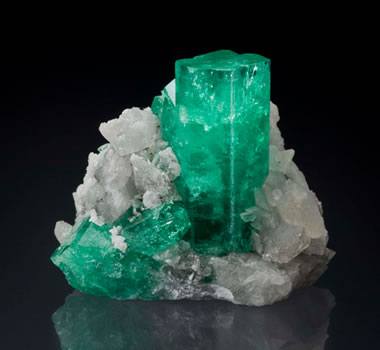
Emerald: Vivid green emerald crystals from the Cosquez Mine in Colombia. The cluster measures 5 x 4.2 x 3 centimeters. Specimen and photo by Arkenstone / www.iRocks.com.
Emerald
Emeralds are gem-quality specimens of beryl that are defined by their green color. To be considered an "emerald," a stone must have a rich, distinct color in the bluish green to green to yellowish green range. If the color is not a rich saturated green, the stone should be called a "green beryl" instead of an "emerald."
There are often disagreements between buyers and sellers on judging the color boundary between emerald and green beryl. Some also believe that the name "emerald" should be reserved for stones with a green color caused by chromium rather than by vanadium. Material colored by iron is almost always too light to be called emerald and usually lacks the distinct green color typically associated with emerald.
Emerald is the most popular and valuable variety of beryl. It serves as the only birthstone for the month of May. Because it is the world's most popular green gemstone, an alternative birthstone was not designated.
Excellent emerald crystals are often more highly valued for use as collector specimens than as gems. Cutting them into faceted gems would be a huge financial loss. Many people collect specimens of gem minerals because they are treasured not only for their ability to be used to produce gems, but also for their desirability as mineral specimens.
Emerald, sapphire and ruby are considered to be the "big three" of colored stones. More money is spent on these in the United States than all other colored stones combined. In many years, the United States imports a higher dollar value of emerald than of ruby and sapphire combined. Colombia, Zambia, Brazil, and Zimbabwe are major producers of gem-quality emerald. A small amount of emerald is sporadically mined in the United States near Hiddenite, North Carolina.
Emerald is a beautiful gem, but it is often fractured or highly included. Most of the emerald entering the retail market has been treated in some way. Fractures are often impregnated with glass or resins to stabilize the stone and make the fractures less visible. Stones are often waxed or oiled to hide fractures and surface-reaching inclusions. Heating and drilling are often done to reduce the visibility of inclusions.
Even after these treatments, a person with a small amount of knowledge can usually look into a display case at the typical mall jewelry store and with reasonable success identify natural stones and lab-created stones by their clarity. Lab-created stones have a bright green color and are transparent. Natural stones are usually translucent or have visible inclusions and fractures. Natural stones without these characteristics are extremely rare and have a very high price.
Many people prefer natural stones and their visible flaws. Others prefer the clarity and color of lab-created stones and their significantly lower price. Lab-created emeralds account for a significant percentage of the stones on display and being sold in many department stores and mall jewelry stores.

Aquamarine Crystals: A specimen of aquamarine on feldspar from the Skardu District of Pakistan. The specimen is approximately 14 x 12 x 7.5 centimeters in size. Specimen and photo by Arkenstone / www.iRocks.com.
Aquamarine
Aquamarine is the second-most-popular gem beryl and is the birthstone for the month of March. Like emerald, its identity is defined by its color. Aquamarine has a distinct greenish blue to blue color. Unlike emerald, light-colored stones in this color range are still called aquamarine. The stones that are richly colored are the most desirable, and the stones with a very pale color are made into inexpensive jewelry.
Aquamarine differs from emerald in another way - it normally has far fewer inclusions and fractures. Most of the aquamarine seen in mall jewelry stores is usually eye clean and without visible fractures.
The color of aquamarine can usually be improved by heating. Most stones entering the retail market have been heated. Many of the greenish blue stones offered for sale were distinctly bluish green or even yellow beryl before treatment.
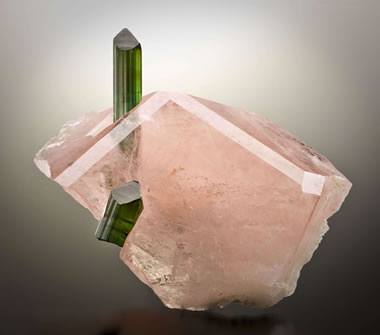
Morganite: An interesting specimen of morganite with tourmaline crystals from the Pederneira Mine in Minas Gerais, Brazil. This specimen has been nicknamed the "Sword in the Stone." Approximately 13.8 x 8.0 x 11.7 centimeters in size. Specimen and photo by Arkenstone / www.iRocks.com.
Morganite
Morganite, also known as "pink beryl" and "rose beryl," is a rare variety of beryl that ranges in color between yellowish orange, orange, pink, and lilac. "Rose," "salmon," and "peach" are common words that have been used to describe morganite's colors. Trace amounts of manganese are the cause of color in most morganite.
Morganite is the third most commonly seen variety of beryl in jewelry stores, but the selection is often limited, and stones with top color are very hard to find. Most morganite sold in jewelry has been heat treated to improve its color. Heating generally removes traces of yellow from the stone and converts orange or yellowish stones into a more desirable pink color. Some morganite has been irradiated to deepen its color. Synthetic morganite has been produced but has not been widely marketed because morganite is not well known to consumers.
Until about 2010, three things severely limited the popularity of morganite: 1) most specimens were very light in color; 2) jewelry manufacturers were hesitant to make a large commitment to the gem because they did not have a steady source of supply; and, 3) consumers were not familiar with morganite because it had never been strongly promoted.
However, starting in about 2010, discoveries of morganite in Brazil and improved methods of heat treatment increased the supply of morganite and improved the color of material with a weak saturation. Since then an increasing amount of moranite jewelry has been appearing in stores.
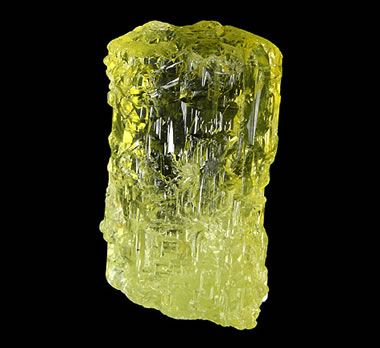
Heliodor: A highly etched greenish yellow heliodor crystal of gem quality from Ukraine. The etching most likely occurred when acidic hydrothermal solutions came into contact with the crystal. Approximately 4.4 x 2.5 x 2.0 centimeters in size. Specimen and photo by Arkenstone / www.iRocks.com.
Heliodor
Yellow beryl, also called "golden beryl" or "heliodor," is a yellow to greenish yellow beryl. Yellow beryl is a durable stone that often has a beautiful yellow color and a relatively low price. The public is not especially familiar with the gem, and as a result the demand is low and so is the price. People who enjoy yellow gems and want an item of jewelry with a yellow beryl will have a hard time finding it at most jewelry stores. It is most often seen in the inventory of a jeweler who does custom designs.
A few vendors call it "yellow emerald." This name is inappropriate because the name "emerald" is by definition a beryl of green color. The Federal Trade Commission has proposed revising its Guides for the Jewelry, Precious Metals and Pewter Industries to state that incorrect usage of varietal names is “unfair” and “deceptive.” Their proposal points directly to “yellow emerald” as an example of a misleading name.
This is a direct quote from the Federal Trade Commission's Guides for the Jewelry, Precious Metals, and Pewter Industries (page 7, section V):
"The Commission proposes adding a new section that states it is unfair or deceptive to mark or describe a product with an incorrect varietal name.14 Varietal names describe a division of gem species or genus based on color, type of optical phenomenon, or other distinguishing characteristic of appearance (e.g., crystal structure). Based on consumer perception evidence, this proposed section provides two examples of markings or descriptions that may be misleading: (1) use of the term “yellow emerald” to describe a golden beryl or heliodor, and (2) the use of the term “green amethyst” to describe prasiolite."
Small amounts of iron are thought to produce the color of yellow beryl, which can often be changed with heating or irradiation. Despite the fact that many specimens of yellow beryl depreciate with treatment to less valuable colors, some specimens can be heated to a greenish blue similar to aquamarine, while others can be irradiated to produce a more desirable yellow color. Those with plans to treat yellow beryl must experiment because treatment success is variable.
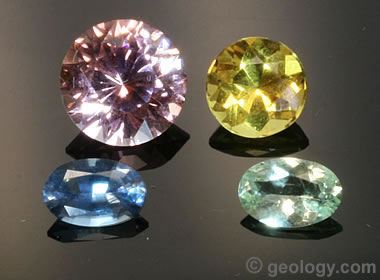
Beryl Gems: Faceted beryl gems, clockwise from bottom left: aquamarine, morganite, and heliodor, all from Madagascar; green beryl from unknown locality.
Green Beryl
"Green beryl" is the name given to light green specimens of beryl that do not have a tone and saturation dark enough to merit the name "emerald." Some of this light green beryl is colored by iron and lacks the distinct green color associated with emerald. Some is colored by chromium or vanadium and does not have the proper hue, tone, and saturation to be called "emerald."
The price difference between green beryl and emerald is significant, so some buyers or sellers hope to have specimens judged in their favor. This can lead to problems because a precise color boundary between emerald and green beryl has not been defined with industry-wide agreement. Green beryl can be an attractive gem, but it is rarely seen in jewelry.
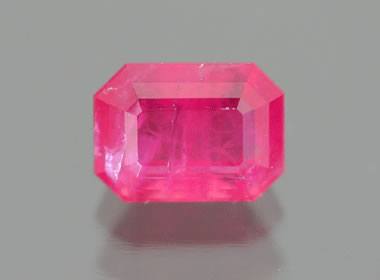
Natural Red Beryl: The photo above shows a faceted red beryl with a beautiful medium red color. It measures about 5.2 x 3.9 millimeters in size. From the Wah Wah Mountains of Utah. Photo by TheGemTrader.com.
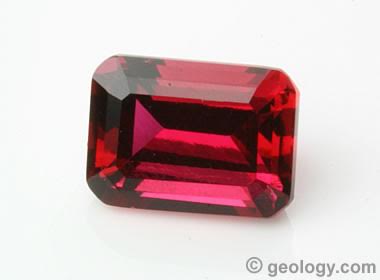
Lab-Created Red Beryl: Synthetic red beryl has the same composition and physical properties as a naturally occurring stone. The gem in the photo weighs 1.23 carats and measures 7.4 x 5.4 mm. Finding a red beryl of this size and clarity in nature would be nearly impossible.
Red Beryl
Red beryl is one of the world's rarest gem materials. Gem-quality material that is large enough to facet has been found in very modest amounts in the Wah Wah Mountains and Thomas Range of Utah. Occurrences of red beryl have been found in the Black Range of New Mexico, but crystals there are just a few millimeters in length and are generally too small to facet.
Red beryl usually has a strong and attractive red color. It has a high enough saturation that even small gems have a very strong color. This is fortunate because most gems cut from red beryl are very small and only suitable for cutting into melee. Gems over one carat in size are very rare and sell for thousands of dollars per carat. The material is often included and fractured, and these characteristics are accepted just as they are accepted in emerald.
In Utah, the host rocks of red beryl are rhyolitic lava flows. Here, crystals of red beryl formed in small vugs and shrinkage cracks long after the rhyolite crystallized. It is thought that ascending beryllium-rich gases encountered descending mineral-rich groundwater to create the geochemical environment needed to form red beryl. Trace amounts of manganese are thought to cause the color.
Beryl is a relatively rare mineral because beryllium rarely occurs in large enough quantities to produce minerals. Red beryl is extremely rare because the conditions needed to supply the color-producing manganese at the proper time to a beryl-forming environment is improbable. So, the formation of red beryl requires the nearly impossible coincidence of two very unlikely events.
Red beryl was initially named "bixbite" after Maynard Bixby, who first discovered the material. That name has been mostly abandoned because it was so often confused with bixbyite, a manganese iron oxide mineral also named after Mr. Bixby. Some people call it "red emerald," but that name is rejected by many in the trade because it causes confusion with another variety of beryl named "emerald."
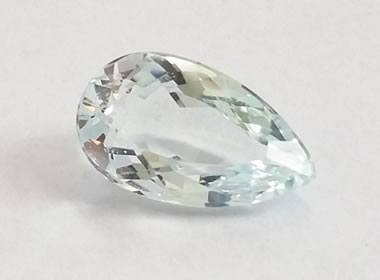
Faceted Goshenite: This specimen displays the excellent clarity and transparency that are frequently seen in goshenite. Image by DonGuennie, used here under a Creative Commons license.
Goshenite
Goshenite is the name used for colorless beryl. In most cases, color in beryl is caused by trace amounts of certain metals that impart a color. That is often the case for goshenite, but color-inhibiting elements can also keep goshenite colorless.
Goshenite is often found in large hexagonal crystals with exceptional clarity and transparency. In the Middle Ages these crystals were cut and polished into lenses for hand magnifiers, telescopes, and some of the earliest eyeglasses. With a Mohs hardness of 7.5 to 8.0, these were some of the earliest scratch-resistant lenses.
Goshenite is sometimes cut into gemstones. These gems are mainly of interest to collectors. They are rarely used in jewelry, because they lack color and their appearance is inferior to other colorless gems such as diamond and white sapphire.
Maxixe
Another rare beryl is a very dark blue material known as "maxixe" (pronounced "mashish"). The dark blue color is thought to be developed in the ground by exposure to natural radiation. Maxixe has an unfortunate problem: the wonderful blue color quickly fades in daylight to a pale brownish yellow color. The color can be restored with additional irradiation, but that color is also quickly lost with exposure to light. Maxixe was first found in 1917 in a mine in the Minas Gerais area of Brazil. It has since been found in small amounts at a few other locations.
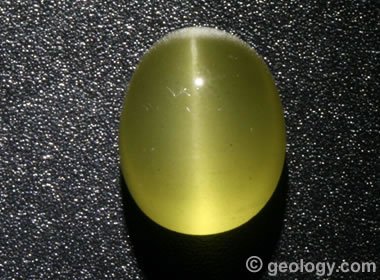
Cat's-Eye Beryl: This yellow heliodor is made from rough that was mined in Madagascar and cut into a 10 x 8 millimeter chatoyant oval. It has a beautiful translucent color and a faint eye.
Chatoyant Beryl
Beryl occasionally contains a fine silk that allows it to be cut into chatoyant gems. Aquamarine, golden beryl, and emerald are the most likely beryls to be found with chatoyance. When properly oriented and cut en cabochon, these gems usually produce a weak cat's eye, but occasionally a strong cat's eye is produced.
The most valuable chatoyant beryls are those with a highly desirable color and a bright, thin eye that perfectly bisects the gem.
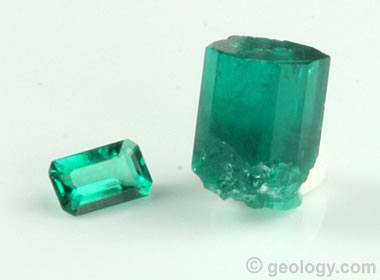
Lab-Created Emerald: Synthetic emeralds can be created in a lab, and these stones are usually superior to natural emerald in their clarity and color. The emeralds in this photo were made by Chatham Created Gems. The faceted stone measures 5.1 x 3 mm and weighs 0.23 carats. The emerald crystal on the right measures about 8 x 6 x 5 mm and weighs about 2 carats.
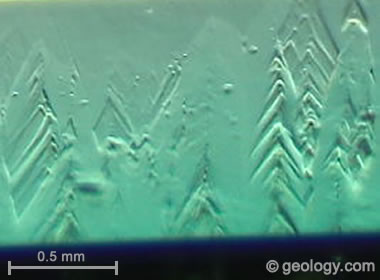
Identifying Synthetic Beryl: Much of the synthetic beryl made by the hydrothermal growth process will show evidence of its synthetic origin. The most common evidence is the presence of chevron-type growth zoning, shown here in a synthetic emerald.
Synthetic Beryl
Synthetic beryl has been commercially manufactured for gemstone use since the 1930s. Synthetic beryls have the same chemical composition and physical properties as natural beryl. They can be fashioned into gemstones that rival the beauty of natural gems and can be sold for a much lower cost. Many people opt for a synthetic emerald because it can have a superior color, superior clarity, greater durability, and a much lower cost than a natural gem.
Today, you can visit any mall in the United States, walk into the first fine jewelry store that you see, and there is a good chance that you will be able to find synthetic beryl in a rich green color, being sold as synthetic emerald. Synthetic emerald jewelry sets consisting of a ring, earrings and pendant are commonly sold in the $299 to $499 price range.
These sets of synthetic emerald jewelry are extremely popular. They allow the shopper to purchase a beautiful synthetic emerald in a low-karat gold setting at a price that most people can afford. Rings with a nice synthetic emerald as a center stone surrounded by small natural diamonds and set in 18-karat gold are sold in many fine jewelry stores. Without a doubt, a significant percentage of the emeralds sold today are synthetic.
Much of the synthetic beryl being produced today is made by the hydrothermal growth process. Synthetic beryl can often be separated from natural beryl with a microscope, by searching for signs of the hydrothermal growth process under reflected light and darkfield illumination at magnifications between 10x and 40x. Chevron growth features are the most common and easiest to find evidence of synthetic growth (see accompanying photo). Synthetic beryls might also contain characteristic inclusions or have a refractive index that is different from natural beryl.
Find Other Topics on Geology.com:

|

| ||

|

| ||

|

| ||

|

|



